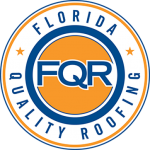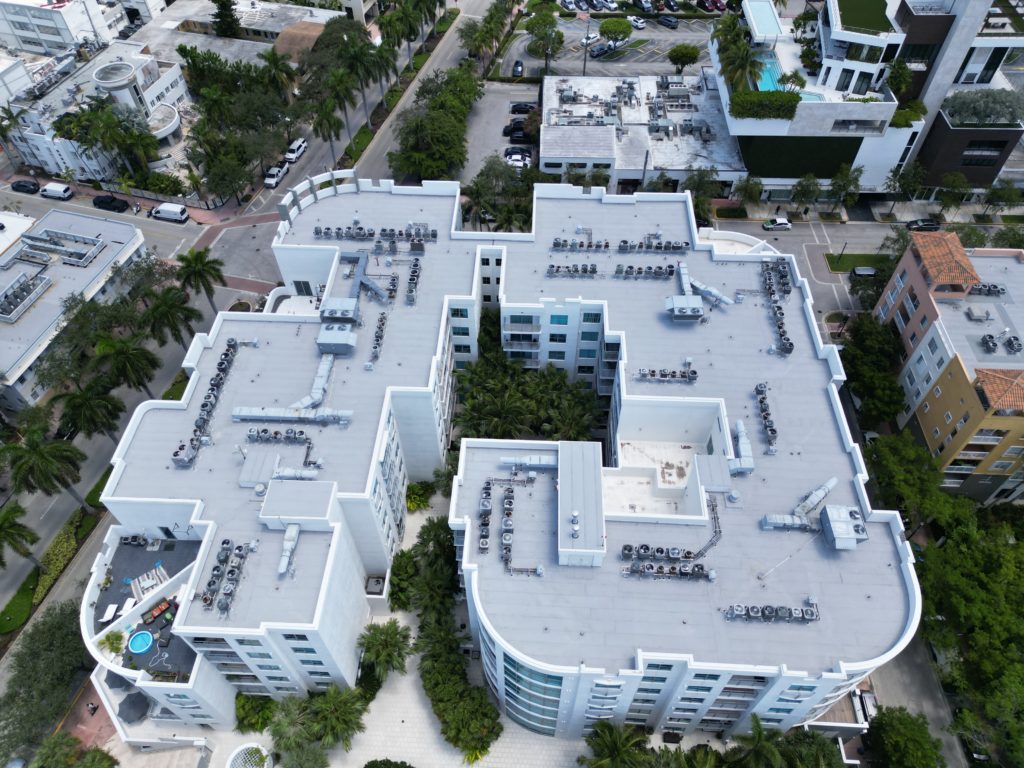There’s a good reason why that pointed roof is the first thing that comes to mind when you picture a house. Most residential roofs are sloped, and this is an intentional choice.
But why is this? Is there anything inherently good or bad about a sloped roof or a flat roof in Florida?
Let’s discuss the pros and cons of flat roofs.
The advantages of sloped roofs
A sloped roof easily allows rainwater to flow down the roof and into the gutter. This prevents standing water and rot and reduces the formation of mold or algae on the roof.
For more northern climates, the slope helps snow slide off before it gets so heavy that it collapses the roof.
In Florida, sloped roofs help with wind mitigation during hurricanes — particularly if they are hip roofs. Hip roofs have slopes on all four sides and provide the best protection in hurricane force winds.
Roofs with a lower slope are more vulnerable to uplift forces during high winds.
The reasons for residential flat roofs in Florida
In some Florida homes, we do see “flat” roofs. This is most likely due to home modifications over the course of the home’s history. As much as 60 percent of all residential houses in South Florida have flat roofs due to additions over the years.
Perhaps the home was built with a carport, which was popular in the 50s, 60s and 70s. The carport roofs were flat and built right up alongside the house. Over the years, these carports were converted into fully enclosed rooms. Or, new homeowners added a new wing to the back of their home.
Usually, you can’t add any additional pitch to these additions, so they opt for a flat roof instead. What you end up with is a combination of sloped roof on part of the house and a flat roof in the front from the converted carport or in the back from an addition.
In a few cases, we find modern homes with intentional flat roofs. Think townhomes or even modern square or rectangular homes, where the architect liked the idea of clean lines.
In other instances, a home has a flat roof because it has a lanai or a covered pool area. These homes can’t be modified unless you remove the entire roof structure and get an architect to design new trusses, which is not realistic in most instances.
What is a flat roof?
If the roof is done the right way, even these “flat” roofs aren’t typically completely flat.
Most houses or buildings with “flat” roofs actually use a low slope roofing system. This means the slope is less than a two-inch rise for every foot of roof.
If the roof is completely flat, there won’t be enough of an angle to allow water to run off of it. Florida building code does not allow us to install new tile, shingle or metal covering on a completely flat roof due to the need for water runoff.
When we install flat roof systems, we use hot asphalt or a torch. We might also use a product called Self-Adhered, which is a clean roofing system where we basically peel a film off of the back, and it sticks onto the roof.
In most cases, flat roofs are found on commercial properties or multi-unit residential buildings but not single-family houses. Residential buildings are often designed with flat roofs so that the roof can house multiple AC units and equipment stands.
The cons of a truly flat roof
Sometimes when homeowners installed an addition to their home or enclosed the carport, they did not slope the trusses enough to create positive drainage. This makes the roof truly flat, and that’s a problem.
When we re-roof these flat roofs, the Florida Building Code now states that every flat roof must have a minimum of a quarter inch pitch so the water can drain.
If water sits on your roof for at least 48 hours, you have what the National Roofing Contractors Association defines as “ponding water.” Ponding water on a roof is the enemy because it will deteriorate everything.
This is a serious problem that causes damage over time.
Unfortunately, many roofing companies will simply redo the flat roof with the same kinds of materials. That doesn’t fix the underlying problem. The rainwater still can’t drain off the roof, and the ponding water continues to cause damage.
How to fix ponding water
Our solution is a bigger initial investment that saves you from spending more on repairs in the future.
What we do is to create a slope by installing tapered insulation. Using 4×4 boards with polyisocyanurate insulation, we build up a slope half inch at a time, layering the boards like a puzzle, one after another. Over these boards, we install the plies that will compose the flat roof system.
This fixes the problem of the ponding water while creating some insulation for the room beneath it.
Our solution also significantly impacts the warranty of your roof. A typical flat roof typically has a warranty of 10 to 15 years. Our flat roof solutions come with up to a 25-year warranty, since we ensure that the roof does not pond water.
The pros of commercial flat roofs in Florida
When you come across an intentionally flat roof in Florida, it’s likely on a commercial property or on a residential building such as an apartment complex or a condominium.
The main reason for flat roofs on shopping centers, high rises, malls and plazas is because of the necessity for rooftop equipment. A restaurant or a hotel may need kitchen hood vents on the roof. Other examples include air conditioner units, satellites, antennas, and other equipment.
Some buildings even decide to use a flat roof to install solar panels without them being noticeably visible from the street.
For other businesses, the advantage of a flat roof comes is signage. This comes into play for buildings like shopping plazas with large signs above the entrance to each store. To accommodate these signs, commercial builders create a parapet wall — a section of wall that is higher than the roof line.
Multifamily residences often have flat roofs as well. In apartment buildings, each apartment unit has an individual air conditioner unit, so these are placed on a flat roof. Then, individual conduit lines run down through the interior walls to each family’s apartment unit.
The advantage of a flat roof for multifamily residents is aesthetics; all of those AC units would not look good if they were installed on the ground.
However, flat roofs, even if they’re intentional, don’t last as long as sloped roofs. Flat roofs on commercial properties, apartments or condos typically last for no more than 20 years. Then they need to be replaced.
In those installations, when needed we work hand-in-hand with HVAC and plumbing contractors — and anyone else connected to equipment on the roof — to coordinate the re-roofing process.
Whatever the slope, we can handle it
Whether your roof is sloped properly or too flat for comfort, we’ve got you covered. We have the expertise, experience and knowledge to handle any roofing job.
To schedule a consultation, give us a call: 954-458-6095.

